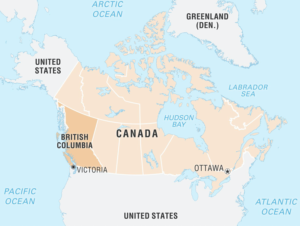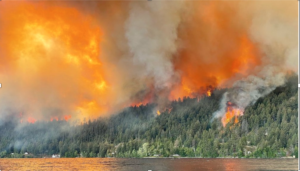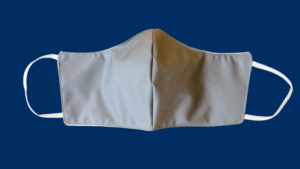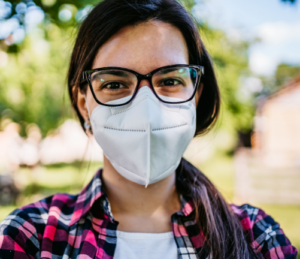Hazy Days: Protecting the Health of British Columbians from Annual Wildfire Air Pollution
by Karen Winquist
January 23, 2024
About the Author:
Karen Winquist has been a Registered Nurse for 35 years and lives in British Columbia, Canada.
She is currently a Master of Public Health student at the University of Edinburgh.
Wildfires in British Columbia

Location of British Columbia, Canada [1]
The Canadian province of British Columbia (BC) covers 95 million hectares, and almost two-thirds of it is. forested. [2] While wildfires are not unusual in BC, its fire seasons have recently lasted longer and started earlier than in the past. [3] These severe wildfire seasons are expected to continue as BC summers have become hotter and drier due to climate change. [4] The resulting poor air quality hazes not only cover the fire-affected areas of BC but drift to other non-affected areas also. [3] Now that smoky summers are the new normal it will impact the health of British Columbians.
 BC forest fire [5]
BC forest fire [5]
I became aware of this health issue during my Master of Public Health program and was soon concerned about its short and long-term health impacts on those in BC, where I live. My concern increased further when, after discussing it with family, friends, and colleagues, I found very few were aware of this issue, and even fewer felt the need to do anything to protect their health during poor air quality events. This blog is part of my commitment to inform as many people as possible about this new public health issue and related health protective strategies.
How do wildfires affect health?
While the specific composition of emitted wildfire pollutants varies due to many factors, [6] many studies on the health risks of airborne particles have found that fine particulate matter is the air pollutant most consistently elevated in wildfire smoke. [7] Decades of research on the health effects of fine particulate matter have demonstrated its high health risks as it is inhaled deeply into the lungs, enters the bloodstream, and circulates throughout the body. [8] Studies have linked fine particulate matter to short and long-term health conditions such as acute and chronic respiratory disease, pulmonary disease, heart disease, strokes, cancer, obesity, diabetes, early-onset Alzheimer’s disease, increases in fetal, infant, and child mortality, and lifelong cognitive/neurodevelopment disorders. [9-12]
What can BC learn from Indonesia?
The chronic health effects of long-term repeated seasonal wildfire smoke exposure have not been extensively studied; however, information on its detrimental health effects is emerging. [8] While BC’s change to severe and prolonged annual fire seasons is recent, Indonesia has experienced them since 2013 primarily due to slash-and-burn agricultural land clearing to meet the increasing worldwide demand for palm oil. Studies have linked long-term repeated wildfire smoke exposure in Indonesia to higher premature mortality (death) risks and increasing noncommunicable disease deaths from causes such as heart and respiratory illnesses [10,13,14] Although more research is needed, current evidence on wildfire smoke exposure supports its association with adverse health outcomes and significant population disease burdens. [15]
Current wildfire health protection measures in BC
Air quality advisories are frequent in BC during wildfire seasons and identify those at high risk of detrimental health effects from smoke exposure as children, seniors, and those with heart or breathing problems. [16] However, infants, teens, pregnant women, diabetics, the obese, former/current smokers, people of colour, and those of low socioeconomic status are also known to be high-risk. [17] While these groups are more vulnerable, ultimately, fine particulate matter is a health risk to all, as no amount is safe to inhale. [17] Unfortunately, many people are unaware of this fact, and wildfire smoke risks are commonly underappreciated and misperceived by the public. [18]
 Walking in the haze. [19]
Walking in the haze. [19]
What can those in BC do to protect their health from wildfire smoke?
Fortunately, BC’s change to severe annual fire seasons is recent, so a window of opportunity exists to prevent many related health issues. There are many ways individuals can protect themselves from the harmful effects of wildfire smoke during BC’s annual fire seasons.
Reduce exposure to particulate matter:
- Stay indoors during poor air quality events as much as possible. [20]
- When required to be outside wear well-fitted particle respirators such as N95 masks for GREATEST PROTECTION. [20]
 N95 Mask. [21]
N95 Mask. [21]
- If an N95 mask is not available, MODERATE PROTECTION can be achieved using:
Well-fitted (no gaps between mask and face) disposable surgical masks or well fitted 3-layer cloth masks. [22,23]
 Surgical Mask [21]
Surgical Mask [21]
 3-layer cloth mask. [21]
3-layer cloth mask. [21]
- 1-layer cloth masks, scarves, or bandannas provide NO PROTECTION. [22.23]
Approximately 65% of outdoor air particle exposure occurs indoors [24]:
- Keep doors and windows closed. [6]
- Use filters on home heating, ventilation, and air conditioners. [6]
- Use portable air cleaners. [6]
- Seal your home’s building envelope. [6]
- If protecting the entire home is not feasible, protect a room where a significant amount of time is spent. [6]
- Visit community clean air shelters for respite. [6]
- Consider relocating temporarily or permanently to an area with better air quality. [6]
- When driving close windows and use cabin filters. Use air-conditioning on recirculate mode but to avoid high exhaled carbon dioxide levels, briefly open car widows every 15 minutes. [25,26].
Repeated annual wildfire smoke exposure is a new public health issue in BC. Public awareness and the use of protective strategies will reduce its detrimental health impacts and help keep all living in BC safe and healthy.

[21]
References
- McDonald, R., Johnston, H., Lawrence, J. British Columbia.In: Encyclopedia Britannica [Internet]. 2024 [cited 2024 January 18]. Available from: https://www.britannica.com/place/British-Columbia
- Government of British Columbia. British Columbia’s forests and their management [Internet]. 2003 [cited 2023 October 5]. Available from: https://www.for.gov.bc.ca/hfd/pubs/Docs/Mr/Mr113/index.htm
- Lindsey, B. There are complex reasons for our dire wildfires, but scientists say climate change plays a key role [Internet]. 2023 [cited 2023 September 24]. Available from: https://www.cbc.ca/news/canada/british-columbia/wildfire-factors-climate-change-1.6939911#:~:text=But%20climate%20change%20is%20an,as%20a%20factor%20of%2011
- Parisien, M., Barber, Q., Bourbonnais, M., Daniels, L., Flannigan, M., Gray, R., Hoffman, K., Jain, P., Stephens, S., Taylor, S., Whitman., E. Abrupt, climate-induced increase in wildfires in British Columbia since the mid-2000s.Commun Earth Environ. 2023; 4: 309.
- Charlebois, B. Properties destroyed as latest BC wildfires’ flames forcing urgent evacuations [Internet]. 2023 [cited 2023 September 24] Available from: https://vancouversun.com/news/local-news/properties-destroyed-as-latest-b-c-wildfire-flares-forcing-urgent-evacuations
- Hadley, M., Henderson, S., Brauer, M., Vedanthan, R. Protecting cardiovascular health from wildfire smoke.Circulation. 2022; 146(10): 788-801.
- Naeher L., Brauer M., Lipsett M., Zelikoff J., Simpson C., Koenig J., Smith, K. Woodsmoke health effects: a review. Inhal Toxicol. 2007; 19: 67–106.
- Rice, M., Henderson, S., Lambert, A., Cromar, K., Hall, J., Cascio, W., Smith, P., Marsh, B., Coefield, S., Balmes, J., Kamal, A. Respiratory impacts of wildland fire smoke: future challenges and policy opportunities. An official American Thoracic Society workshop report.Annals of the American Thoracic Society. 2021; 18(6): 921-930.
- United Nations Children’s Fund (UNICEF). Air pollution: a threat to children’s health in Indonesia [Internet]. 2018 [cited 2023 September 25] Available from: https://www.vitalstrategies.org/wp-content/uploads/2018/07/Vital-Strategies-Air-Pollution-Evidence-Brief-Indonesia.pdf
- Kadandale, S., Marten, R., Smith, R. The palm oil industry and noncommunicable diseases.Bulletin of the World Health Organization. 2019; 97(2) 118.
- Air Quality in Indonesia [Internet]. 2023 [cited 2023 September 25] Available from: https://www.iqair.com/indonesia
- Yeung, J. Indonesian fires are burning, and Malaysia and Singapore are choking on the fumes [internet]. 2019 [cited 2023 September 24] Available from: https://www.cnn.com/2019/09/11/asia/malaysia-singapore-pollution-intl-hnk/index.html
- World Health Organization (WHO). Noncommunicable diseases progress monitor [internet]. 2022 [cited 2023 September 24] Available from: https://www.who.int/publications/i/item/9789240047761
- Greenstone, M., Fan, Q. Indonesia’s worsening air quality and its impact on life expectancy [internet]. 2019 [cited 2023 September 28] Available from: https://aqli.epic.uchicago.edu/wp-content/uploads/2019/03/Indonesia-Report.pdf
- Rajagopalan, S., Al-Kindi, S., Brook, R. Air pollution and cardiovascular disease: JACC state-of-the-art review. J Am Coll Cardiol. 2018; 72: 2054– 2070.
- Government of British Columbia. Air quality health index [internet]. 2023 [cited 2023 October 15] Available from: https://www.env.gov.bc.ca/epd/bcairquality/data/aqhi-table.html
- American Lung Association. Particle pollution [internet]. 2023 [cited 2023 September 25] Available from: https://www.lung.org/clean-air/outdoors/what-makes-air-unhealthy/particle-pollution
- Smallbone, K. Report: individuals’ interpretation of air quality information: customer insight and awareness study [internet]. 2010 [cited 2023 October 10] Available from: https://uk-air.defra.gov.uk/library/reports?report_id=719
- Shingler, B. Why the air quality Index needs an upgrade to better measure wildfire smoke [internet]. 2023 [cited 2023 September 25] Available from: https://www.cbc.ca/news/science/aqhi-wildfire-smoke-air-quality-1.6947977#content
- Landrigan, P., Fuller, R., Acosta, N., Adeyi, O., Arnold, R., Basu, B., Balde, A., Bertollini,R.,Bose-O’Reilly, S., Boufford, J., et al. The Lancet Commission on pollution and health. Lancet. 2017; 391: 462–512.
- Hunter Medical Research Institute (HMRI). Masks protect from Covid- 19, but which mask is best? [internet]. 2022 [cited 2024 January 16] Available from: https://hmri.org.au/news-article/masks-protect-against-covid-19-which-mask-best
- Konda, A., Prakash, A., Moss, G., Schmoldt, M., Grant, G., Guha, S.Aerosol filtration efficiency of common fabrics used in respiratory cloth masks. ACS Nano. 2020; 4: 6339–6347.
- Stone, S., Sacks, J., Lahm, P., Clune, A., Quinn, T., D’Alessanndro, M., Radonovich, L., Hutson, M., Mirabelli, M. Wildfire Smoke: a Guide for Public Health Officials [internet]. 2021 [cited 2023 October 10] Available from: https://www.airnow.gov/publications/wildfire-smoke-guide/wildfire-smoke-a-guide-for-public-health-officials/
- Fisk, W. Chan, W. Effectiveness and cost of reducing particle‐related mortality with particle filtration.Indoor Air. 2017; 27(5): 909-920.
- Tartakovsky, L., Baibikov, V., Czerwinski, J., Gutman, M., Kasper, M., Popescu, D., Veinblat, M., & Zvirin, Y. In-vehicle particle air pollution and its mitigation. Atmos Environ. 2013; 64: 320–328.
- Chuang, H., Lin, L., Hsu, Y., Ma, C., Chuang, K. In-car particles and cardiovascular health: an air conditioning-based intervention study. Sci Total Environ. 2013; 452: 309–313.



